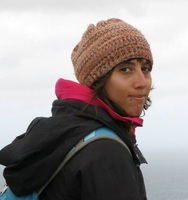Behind the science:
Feeding biology of a habitat-forming antipatharian in the Azores Ar...
2020, October 13
Posted by Veronica Radice
Fields
Physiology
Focusgroups
Antipatharia (Black Corals)
Locations
Portugal - Azores
Platforms
SCUBA (open-circuit or unspecified)
“Feeding biology of mesophotic black coral”
What was the most challenging aspect of your study (can be anything from field, lab to analysis)?
Throughout the study we had quite some challenges, from designing the experimental aquaria to incorporating isotopic labelling in live prey. However, the most challenging part was to create the ideal conditions to maintain the coral fragments in the aquaria. Antipatharians are quite sensitive and demanding species and we had previous experience with removing them from their natural environment and keeping them in our facilities, which were not very satisfying to perform such an experiment. This created some uncertainty, however, during these attempts we learned a lot and modified our system accordingly. In the end, we managed to create suitable conditions to maintain the coral fragments in a good state throughout the experiment.
What was the most memorable moment in undertaking this study?
The most memorable moment was when we realized how efficiently this species could feed on zooplankton. This happened during our preliminary studies, in which we used quite high concentrations of zooplankton prey to find out if rotifers were indeed a good choice for our experiment. Coral fragments fed so much on the available prey that the aquaria water turned crystal clear within a couple of hours. We were all quite amazed by their ability to prey on zooplankton so fast.
What was your favorite research site in this study and why?
We picked up specimens from two sites, one in Faial island called Baixa da Feteira, where black corals can be found on a vertical wall at 18-30m and another in Pico island, called São Caetano where corals can be encountered at 35-40m. Every site has its beauty and drawbacks. In São Caetano, most corals are packed within a crevice, but right next to it, there is an impressive colony with height greater than 2 meters that enchants all divers who try to enjoy the image as much as they can, before their available bottom time finishes. On the other site, colonies are spread along a greater area and can be found much shallower which gives us a lot of time to take our samples and enjoy the rest of the dive. Unfortunately, this site was severely affected by the hurricane “Lorenzo” in 2019, which destroyed most colonies above 25 meters.
Other than your co-authors, with whom would you like to share credit for this work?
This work would have been impossible without Gerald Taranto and David Figueras who have helped immensely during specimen collection. We are also very grateful to Carla Nunes, João Rodeia and Mirko Girolamo who helped us to set up the phytoplankton and zooplankton cultures and create the respective food treatments for our study.
Any important lessons learned (through mistakes, experience or methodological advances)?
Throughout the experiment we gained a better understanding of the species requirements and managed to improve the conditions for its maintenance in the aquaria, especially concerning feeding. As antipatharians are suspension feeders, we expected them to feed on a variety of prey. Although our results confirmed they can prey on different prey types, it became clear that zooplankton is vital for their physiology. Based on our results, we adjusted not only the content but also the quantity and frequency of feeding.
Can we expect any follow-up on this work?
This work is incorporated in a broader attempt to study several aspects of the biology of the species, including its reproduction, larval biology and ecophysiology. At the moment, our next steps are mostly directed to early life stages, but we hope to be able to come back to their feeding biology and build further on this study.
Featured article:
|
|
Feeding biology of a habitat-forming antipatharian in the Azores Archipelago | article Rakka M, Orejas C, Maier SR, Van Oevelen D, Godinho A, Bilan M, Carreiro-Silva M (2020) Coral Reefs |
|




